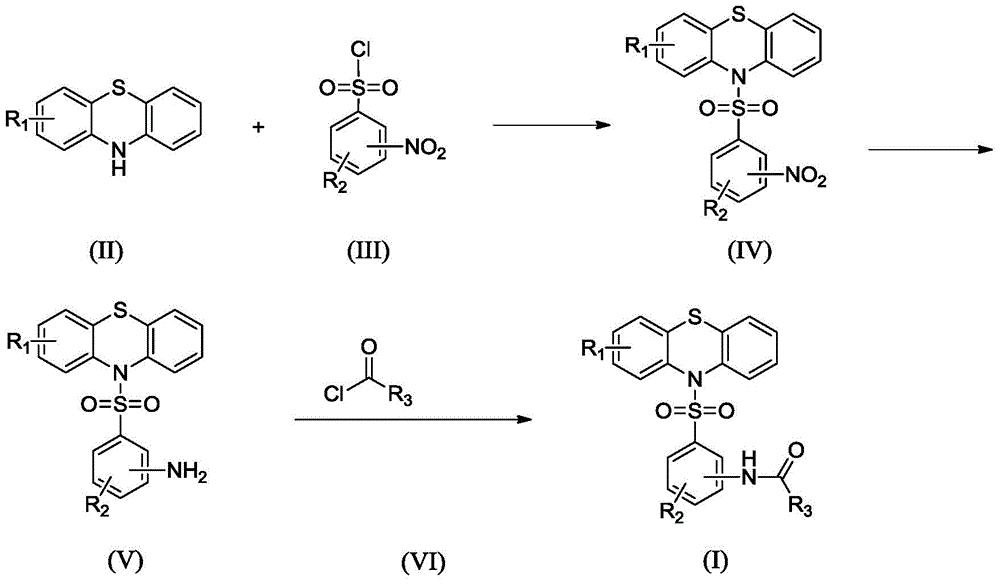N-substituted benzenesulfonyl phenothiazine compound and its preparation method and use
A technology of compound and alkyl, which is applied in the field of medicine, can solve the problems of insufficient physical and chemical properties of benzazepine compounds such as activity and side effects
- Summary
- Abstract
- Description
- Claims
- Application Information
AI Technical Summary
Problems solved by technology
Method used
Image
Examples
Embodiment 1
[0057] Preparation of IV-1
[0058]
[0059] II-1 (100g, 502mmol) was placed in a 1000mL reaction flask, and CH was added 2 Cl 2 (500mL) stirred to make it dissolve, added triethylamine (76g, 750mmol), stirred under ice-water bath, added intermediate III-1 (121.9g, 550mmol) in batches, kept the temperature and stirred for 1h, TLC detection showed that the reaction was finished ( Developing agent ethyl acetate:petroleum ether=1:3).
[0060] The reaction solution was poured into 500ml of cold water, fully shaken to separate the layers, and the organic layer was separated and washed three times in succession. The organic layer was dried over anhydrous sodium sulfate and left overnight. After filtration, the solvent was evaporated to dryness under reduced pressure to obtain a light yellow solid. The resulting product was recrystallized from ethanol to obtain 173 g of a light yellow solid. The purity is 97.9% (HPLC normalization method), and the yield is 89.6%. ESI-MS ([...
Embodiment 2
[0062] Preparation of IV-2
[0063]
[0064] II-1 (20g, 100mmol) was placed in a 250mL reaction flask, and CHCl was added 3 (100mL) was stirred to dissolve, added pyridine (8.7g, 110mmol), stirred and dissolved at 50°C, added intermediate III-2 (23.3g, 105mmol) in batches, kept stirring at the temperature for 3h, TLC detection showed that the reaction was complete (Developer ethyl acetate:petroleum ether=1:3).
[0065] The reaction solution was poured into 100ml of cold water, fully shaken to separate the layers, and the organic layer was separated and washed three times in succession. The organic layer was dried over anhydrous sodium sulfate and allowed to stand overnight. After filtration, the solvent was evaporated to dryness under reduced pressure to obtain a light yellow solid crude product. The resulting crude product was purified by silica gel column chromatography to obtain 34.8 g of a pale yellow solid. The purity is 98.2% (HPLC normalization method), and the...
Embodiment 3
[0067] Preparation of IV-3
[0068]
[0069] Put II-2 (20g, 86mmol) in a 250mL reaction flask, add pyridine (60mL), stir to dissolve, stir under ice-water bath, add intermediate III-3 (20.3g, 86mmol) in batches, keep the temperature and stir for 4h , TLC detection showed that the reaction was complete (developing agent ethyl acetate:petroleum ether=1:3).
[0070] The reaction solution was poured into 300ml of cold water, stirred, and solids were precipitated. After filtering, the filter cake was washed with water and dried to obtain a yellow crude product. The crude product was recrystallized from ethanol to obtain 34.7 g of a light yellow solid. The purity is 98.4% (HPLC normalization method), and the yield is 93.3%. ESI-MS ([M+H]+): 433.0.
PUM
 Login to View More
Login to View More Abstract
Description
Claims
Application Information
 Login to View More
Login to View More - R&D
- Intellectual Property
- Life Sciences
- Materials
- Tech Scout
- Unparalleled Data Quality
- Higher Quality Content
- 60% Fewer Hallucinations
Browse by: Latest US Patents, China's latest patents, Technical Efficacy Thesaurus, Application Domain, Technology Topic, Popular Technical Reports.
© 2025 PatSnap. All rights reserved.Legal|Privacy policy|Modern Slavery Act Transparency Statement|Sitemap|About US| Contact US: help@patsnap.com



